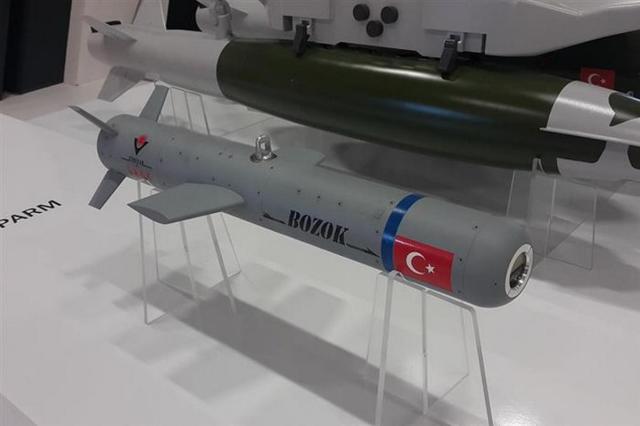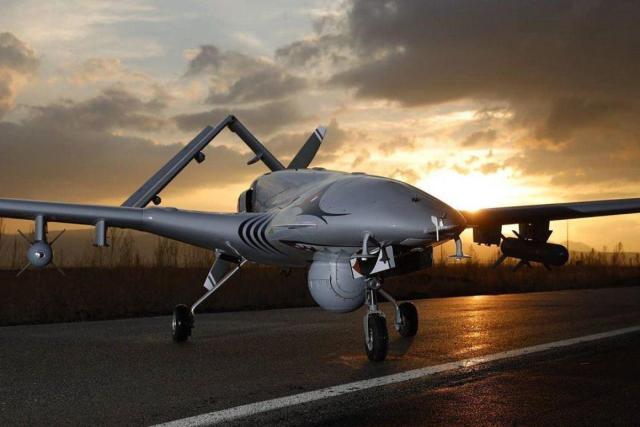Continuation of the article on unmanned aircraft systems in Turkey ( Part I ). This excerpt discusses the main types of ammunition used with Turkish UAVs. The full material is presented here .
Armament
The main suppliers of weapons for Turkish UAVs are Roketsan and the Turkish Defense Industry Research and Development Institute TÜBITAK (SAGE).
The first studies on arming UAVs of different models (such as GNAT-750, I-GNAT, Bayraktar, Malazgirt, ANKA, Bayraktar TB2, Karayel and others) were initiated by Turkish engineers in the early 2010s. In May 2013, the ANKA Blok-A UAV with double guides under each wing for the first time launched two guided combat missiles (SD) with laser guidance CIRIT (manufactured by Roketsan) at a fixed target illuminated by the AselFLIR-300T system.
As the first shootings showed, due to the fact that the ignition of the rocket engine occurred immediately at launch, the accuracy of hitting the target depended on the height of the rocket launch and the dive angle given to it. As a result, the drone needed to descend to a height of about 3000 m (10 thousand feet), which significantly affected its survivability. Therefore, in order to increase the combat stability and effectiveness of the UAV, there was a need for weapons suitable for use from high altitudes. The solution was a system of so-called intelligent ("smart") micro-munitions (Mini Akıllı Mühimmat, MAM) of free fall proposed by Roketsan under the control of a semi-active laser (SAL) homing head (GOS).
In 2016, the company introduced the "smart" ammunition MAM-L, which proved its high efficiency during combat use. The product is a version of the L-UMTAS guided missile without a rocket engine. MAM-L has a length of 1 m, a diameter of 160 mm, a total weight of 22 kg (50 lb), a warhead weight of 10 kg. The latter is equipped with shock and contactless fuses and can be high-explosive, tandem cumulative action or thermobaric.
The range of combat use of the standard version of the MAM-L is limited to 8 km. Under optimal conditions of dropping from a height of about 30 thousand feet, it is possible to destroy a target at a range of up to 14 km. Guidance is carried out using an inertial navigation system or a global positioning system. The presence of a semi-active GPS requires visual contact with the target and its laser illumination, Such illumination can be carried out either from a carrier platform or from another UAV. The effective defeat of a wide range of targets from heavy armored vehicles and fortified field structures to the accumulation of manpower (a radius of 25 m) has been confirmed.

Intelligent micro-munitions MAM-L and MAM-C
The MAM-C ammunition is considered a smaller version of the MAM-L. At the heart of its design is the UR CIRIT without a rocket engine. The micro-munition has a length of 970 mm, a diameter of 70 mm, a total weight of 6.5 kg, a warhead weight of 2.5 kg. Laser illumination of the target is also used for guidance. After the reset, the MAM-C is capable of flying from 8 to 12 km, providing a circular probable deviation (CVO) of up to 3 m. When detonating a multi-purpose warhead, the defeat is achieved due to fragmentation, armor-piercing or incendiary effects on the target. Unarmored vehicles, military objects such as radar stations or openly located enemy personnel can be considered as targets.
According to Roketsan specialists, the use of L-UMTAS and CIRIT base missiles compared to their versions without a rocket engine allows to increase the effectiveness of hitting targets by 30%. Moreover, their use is preferable for hitting moving targets.
At the IDEF-2019 weapons exhibition, Turkey demonstrated a miniature ammunition under the designation "Yatagan". The guided missile has a caliber of 40 mm and a length of 40 cm. The total weight of the product does not exceed 1 kg. According to publications, if used with a UAV, the target range can reach 8 km with a CVO of up to 1 m. The small size and weight of the "Yatagan" allow the UAV to carry up to several dozen such missiles and remain in the operational zone for a longer period of time.
TÜBITAK (SAGE) equips Turkish UAVs with heavy bombs or long-range missiles. TEBER type laser guidance kits are designed for use on MK-81 (250 lb), MK-82 (500 lb), MK-83 (1000 lb) general purpose bombs, as well as on MK-84 (2000 lb) bombs. When bombing from a height of 40 thousand feet, they are capable of reaching a range of up to 25 km. For guidance, this type of ammunition uses mainly an inertial navigation system (INS), a global positioning system (GPS) and a semi-active laser finder (SAL). The use of additional guidance equipment using the wing (Wing Assisted Guidance Kit, tour.adb. – KGK) turns the existing unguided universal bombs MK-82 and MK-83 into long-range intelligent air-to-surface weapons with a CVO within 10 m.
In particular, in April 2021, the aviation Internet resource flugrevue.de reported testing an aircraft bomb (according to a 350 kg source) with a KGK-SIHA-82 kit with folding wings. The test took place on the Black Sea coast, above the landfill in the Sinop area. UAV "Aksungur" dropped a bomb from a height of 6000 m. Reportedly, after that, the munition flew another 30 km under GPS control and successfully hit the designated target. It is expected that in the future KGK-SIHA-82 will be tested at a range of 45 km.

BOZOK Intelligent Ammunition
A separate development of TÜBITAK (SAGE) for UAVs from a series of planning intelligent ammunition was the "BOZOK" (BOZOK). Its tests began in 2018, and the announcement of the start of mass production was expected in the first quarter of 2021. According to open sources, the "Bozok" has a length of 79 cm, a diameter of 10 cm, a total weight of 16 kg, a high-explosive warhead weight of 5 kg. When dropped from a height of 20 thousand feet at a speed of Mach 0.15, the range of application can reach 9 km (estimated 8 km). The product uses an inertial navigation system and a laser guidance system on the final section of the trajectory. It is possible to adjust the power and height of the detonation of the warhead, as well as the angle of dive to the target within 60-80 degrees.
According to some publications, the Turkish defense industry will soon present means to defeat air defense facilities and enemy air targets. In the first case, we are talking about a cruise missile launched from beyond the reach of enemy air defense systems (Stand-Off Missile, SOM). The range of application of such a CR will exceed 200 km, and the total weight will reach 500 kg. Presumably, the UAV "Aksungur" or "Akinci" will be able to carry up to two similar KR. For conducting air combat with the help of UAS, air-to-air missiles are being developed under the designations BOZDOGAN (Merlin) and GÖKDOGAN (Pilgrim). Both rockets are at the design stage.
Based on the publications Jane's International Defense Review, Defense Turkey, European Security & Defense, as well as the resources of magazin.zenith.me, dayan.org,
The full text of the article is framed in a brochure and published here

